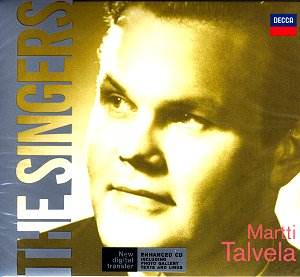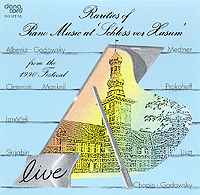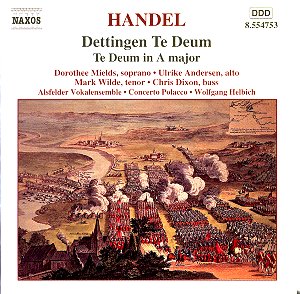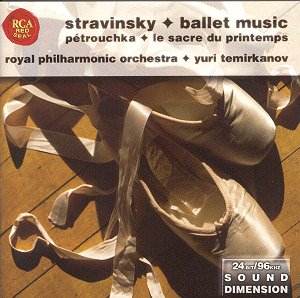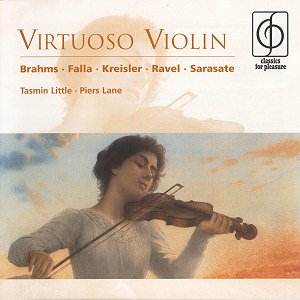 Composer: Fritz Kreisler
Composer: Fritz Kreisler
Works: Praeludium and Allegro “in the style of Pugnani”, Hungarian Dance No. 1 (arr. Joseph Joachim), The Gadfly: Romance (Dmitri Shostakovich), Valse Bluette (Riccardo Drigo, arr. Leopold Auer), Moods, Impressions and Reminiscences, Op. 41: Poème (Zdenek Fibich, arr. Jan Kubelik), La Vida Breve: Danse espagnole (Manuel de Falla, arr. Kreisler), Légende, Op. 17 (Henryk Wieniawski, arr. August Wilhelmj), Introduction and Tarantella, Op. 43 (Pablo de Sarasate), Hungarian Dance No. 5 (Johannes Brahms, arr. Joachim), Baal Shem: Nigun (Ernest Bloch), Beau Soir (Claude Debussy, arr. Jascha Heifetz), Caprice viennois, Op. 2 (Kreisler), The Tale of Tsar Saltan: The Flight of the Bumble Bee (Nicolai Rimsky-Korsakov, arr. Heifetz), Hassan: Serenade (Frederick Delius, arr. Lionel Tertis), Ave Maria, D. 839 (Franz Schubert, arr. Wilhelmj), Banjo and Fiddle (William Kroll), Tzigane Rapsodie de concert (Maurice Ravel)
Performers: Tasmin Little (violin), Piers Lane (pianoforte)
Recording: Recorded at St. Michaels, Highgate, 30-31 July 1991
Label: EMI Classics for Pleasure 574 9492
Tasmin Little’s recording of a collection of violin favorites, aptly titled “Virtuoso Violin,” encapsulates the rich tradition of violin repertoire that spans various styles and historical contexts. Each work included in this compilation reveals not only the virtuosity demanded by the instrument but also the interpretive depth that Little brings to each selection. From Kreisler’s playful “Praeludium and Allegro” to Ravel’s exuberant “Tzigane,” the album showcases how these miniatures remain vital and resonant in contemporary performance.
In analyzing Little’s interpretation, one finds a refreshing blend of technical precision and emotional sincerity. The Brahms dances, particularly the Hungarian Dance No. 1, are infused with a joyous spirit that transcends mere rhythmic exuberance. Little’s command of tempo flexibility, allowing for nuanced shifts that enhance the Gypsy-like character of the piece, is commendable. Unlike many performers who may adhere strictly to the metronomic pulse, her approach breathes life into the phrases, allowing them to blossom organically. This naturalness is also evident in the “Caprice viennois,” where Little eschews the temptation to mimic Kreisler’s own flamboyant style in favor of a warm, personal touch that highlights the work’s lyrical beauty.
The recording quality merits mention, with EMI’s engineering capturing the intimate atmosphere of St. Michaels, Highgate. The balance between violin and piano is particularly well-executed, allowing Piers Lane’s accompaniment to complement rather than overshadow the soloist. The clarity of the piano’s articulation in the Shostakovich Romance provides a poignant backdrop, enhancing Little’s emotive interpretation. However, one notes that the arrangement of Schubert’s “Ave Maria,” while beautifully rendered, feels somewhat out of place amidst the more dynamic selections. Despite its sentimental charm, the arrangement lacks the original’s depth, a sentiment that even Little’s heartfelt sincerity struggles to elevate.
Little excels in the more poignant moments, particularly in the Fibich “Poème” and Delius’s “Serenade,” where her tone becomes ethereal, drawing the listener into a contemplative space. The contrasting brilliance in Wieniawski’s “Légende” showcases her technical prowess, particularly in the middle section, where she navigates the emotional landscape with both passion and precision. The frenetic energy of “The Flight of the Bumble Bee” is executed with dazzling agility, underscoring her status as a formidable interpreter of the virtuosic repertoire.
This recording stands as a testament to the enduring appeal of the violin repertoire, illuminating how these works, beloved of previous generations, can still resonate in a modern context. Little’s artistry and Lane’s sensitive accompaniment create a compelling narrative that invites both the casual listener and the aficionado to engage deeply with the music. The blend of historical significance with contemporary interpretation solidifies “Virtuoso Violin” as an essential addition to any classical music collection, offering a delightful and accessible journey through the violin’s rich heritage.
